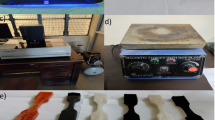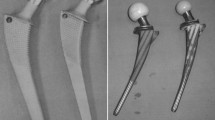Abstract
The aim of the present work is to evaluate the artificial hip joint femur head that is made of Stiffness Graded (SG) material in terms of joint stresses distributions and dimensions. In this study, 3D finite element models of femur head that is made of SG material and traditional femur heads made of Stainless Steel (SS), Cobalt Chromium alloy (Co Cr Mo) and Titanium alloy (Ti) have been developed using the ANSYS Code. The effects on the total artificial hip joint system stresses due to using the proposed SG material femur head (with low stiffness at the outer surface and high stiffness at its core) have been investigated. Also, the effects on the polymeric cup contact stresses due to the use of different sizes of femur heads, presence of metal backing shell and presence of radial clearance (gap) between cup and femur head have been investigated. The finite element results showed that using SG femur head resulted in a significant reduction in the cup contact stresses even for small femur heads compared with Ti alloy, SS and Co Cr Mo femur heads. The presence of radial clearance resulted in significant increase in the cup stresses especially for small femur heads. Finally, the presence of SS metal backing shell resulted in slight increase in the hip joint stresses especially for small femur head joints. This work analyzes successfully the usage of proposed SG material as femur head in order to reduce the predicted stresses at the total hip joint replacement due to the redistribution of strain energy in the hip prostheses. Therefore, the present results suggest that minor changes in design and geometrical parameters of the hip joint have significant consequences on the long term use of the joint and should be taken into consideration during the design of the hip joint.








Similar content being viewed by others
References
Barbour PSM, Barton DC, Fisher J. The Influence of contact stress on the wear of UHMWPE for total replacement hip prostheses. Wear. 1995;181:250–7.
McNie CM, Barton DC, Ingham E, Tipper JL, Fisher J, Stone MH. The prediction of polyethylene wear rate and debris morphology produced by microscopic asperities on femoral heads. J Mater Sci: Mater Med. 2000;11:163–74.
Teoh SH, Chan WH, Thampuran R. An elasto-plastic finite element model for polyethylene wear in total hip arthroplasty. J Biomech. 2002;35:323–30.
Saikko V, Shen M. Wear comparison between a dual mobility total hip prosthesis and a typical modular design using a hip joint simulator. Wear. 2010;268:617–21.
Wilches LV, Uribe JA, Toro A. Wear of materials used for artificial joints in total hip replacements. Wear. 2008;265:143–9.
Ilchmann T, Reimold M, Müller-Schauenburg W. Estimation of the wear volume after total hip replacement. A simple access to geometrical concepts. Med Eng Phys. 2008;30:373–9.
Barnes CL, DeBoer D, Corpe RS, Nambu S, Carroll M, Timmerman I. Wear performance of large-diameter differential-hardness hip bearings. J Arthroplast. 2008;23:56–60.
Affatato S, Bersaglia G, Rocchi M, Taddei P, Fagnano C, Toni A. Wear behaviour of cross-linked polyethylene assessed in vitro under severe conditions. Biomaterials. 2005;26:3259–67.
Korhonen RK, Koistinen A, Konttinen YT, Santavirta SS, Lappalainen R. The effect of geometry, abduction angle on the stresses in cemented UHMWPE acetabular cups-finite element simulations, experimental tests. BioMed Eng Online. 2005;4:32.
Rixrath E, Wendling-Mansuy S, Flecher X, Chabrand P, Argenson JN. Design parameters dependences on contact stress distribution in gait and jogging phases after total hip arthroplasty. J Biomech. 2008;41:1137–42.
Bertram T, Anton H, Johan K, Veronika K, Gunnar F, Nico V, Ron D. Association between contact hip stress and RSA-measured wear rates in total hip arthroplasties of 31 patients. J Biomech. 2008;41:100–5.
Jiang Hai B. Static and dynamic mechanics analysis on artificial hip joints with different interface designs by the finite element method. J Bionic Eng. 2007;4:123–31.
David B, Tarun G. Finite element analysis of hip stem designs. Mater Des. 2008;29:45–60.
Schmid DM, Wullschleger L, Derler S, Schmitt KU. Development of a new design of hip protectors using finite element analysis and mechanical tests. Med Eng Phys. 2008;30:1186–92.
Kang L, Galvin AL, Jin ZM, Fisher J. A simple fully integrated contact-coupled wear prediction for ultra-high molecular weight polyethylene hip implants: Proceedings of the Institution of Mechanical Engineers. Part H J Eng Med. 2006;220:33–46.
Griza S, Cê AN, Silva EP, Bertoni F, Reguly A, Strohaecker TR. Acetabular metal backed fatigue due to severe wear before revision. Eng Fail Anal. 2009;16:2036–42.
Wasielewski RC, Jacobs JJ, Arthurs B, Rubash HE. The acetabular insert-metal backing interface: an additional source of polyethylene wear debris. J Arthroplast. 2005;20:914–22.
Chen FS, Di Cesare PE, Kale AA, Lee JF, Frankel VH, Stuchin SA, Zuckerman JD. Results of cemented metal-backed acetabular components: a 10-year-average follow-up study. J Arthroplast. 1998;13:867–73.
Burger NDL, De Vaal PL, Meyer JP. Failure analysis on retrieved ultra high molecular weight polyethylene (UHMWPE) acetabular cups. Eng Fail Anal. 2007;14:1329–45.
John GB, Thomas KD, Paul AW, Ian CC. Surface damage after multiple dislocations of a 38-mm-diameter, metal-on-metal hip prosthesis. J Arthroplast. 2008;23:1090–6.
Alistair PDE, Richard MH, Ian MP, Anthony U. Wear in retrieved acetabular components: effect of femoral head radius and patient parameters. J Arthroplast. 1998;13:291–5.
Darwish SM, Al-Samhan AM. Optimization of artificial hip joint parameters. Mater Sci Eng Technol. 2009;40:218–23.
Cilingir AC. Finite element analysis of the contact mechanics of ceramic-on-ceramic hip resurfacing prostheses. J Bionic Eng. 2010;7:244–53.
Fouad H, Darwish SM. Effects of femur design parameters on the resultant contact stress on the UHMWPE Cup. In: 4th international conference on advanced computational engineering and experimenting. Paris; 2010.
ANSYS Version 12. ANSYS Inc., Canonsburg; 2009.
Barreto S, Folgado J, Fernandes PR, Monteiro J. The influence of the pelvic bone on the computational results of the acetabular component of a total hip prosthesis. J Biomech Eng. 2010;132(5):054503.
Muratoglu OK, Bragdon CR, O’Connor D, Perinchief RS, Estok DM 2nd, Jasty M, Harris WH. Larger diameter femoral heads used in conjunction with a highly cross-linked ultra-high molecular weight polyethylene: a new concept. J Arthroplast. 2001;16:24–30.
CATIA V5. Dassault Systemes, Mississauga; 2008.
Qingliang W, Jinlong L, Shirong G. Study on biotribological behavior of the combined joint of CoCrMo and UHMWPE/BHA composite in a hip joint simulator. J Bionic Eng. 2009;6:378–86.
Furmanski J, Anderson M, Bal S, Greenwald AS, Halley D, Penenberg B, Ries M, Pruitt L. Clinical fracture of cross-linked UHMWPE acetabular liners. Biomaterials. 2009;30:5572–82.
Fouad H. Experimental and numerical studies of the notch strengthening behaviour of semi-crystalline ultra-high molecular weight polyethylene. Mater Des. 2010;31:1117–29.
Mourad A-H I, Fouad H, Rabeh E. Impact of some environmental conditions on the tensile, creep-recovery, relaxation, melting and crystallinity behaviour of UHMWPE-GUR 410-medical grade. Mater Des. 2009;30:4112–9.
Fouad H, Mourad A-H I, Barton DC. Effect of pre-heat treatment on the static and dynamic thermo-mechanical properties of ultra-high molecular weight polyethylene. Polym Testing. 2005;24:549–56.
Fouad H. Effect of long-term natural aging on the thermal, mechanical, and viscoelastic behavior of biomedical grade of ultra high molecular weight polyethylene. J Appl Polym Sci. 2010;118:17–24.
Hedia HS, Abdel-Shafi AA, Fouda N. Shape optimization of metal backing for cemented acetabular cups. Biomed Mater Eng. 2000;10:73–82.
Wu JS, Hung JP, Shu CS, Chen JH. The computer simulation of wear behavior appearing in total hip prosthesis. Comput Method Program Biomed. 2003;70:81–91.
Chen L, Du X, Zheng Y, Bao Y, Chen M, Hu M, Yu D. Finite element analysis of LTI carbon hip joint head. Bioinformatics Biomed Eng. ICBBE 3rd International Conference; 2009. 11–13 June. p. 1–4.
Kosak R, Antolic V, Pavlovcic V, Kralj-Iglic V, Milosev I, Vidmar G, Iglic A. Polyethylene wear in total hip prostheses: the influence of direction of linear wear on volumetric wear determined from radiographic data. Skeletal Radiol. 2003;32:679–86.
Currey JD. What determines the bending strength of compact bone? J Exp Biol. 1999;202:2495–503.
Author information
Authors and Affiliations
Corresponding author
Rights and permissions
About this article
Cite this article
Fouad, H. In vitro evaluation of stiffness graded artificial hip joint femur head in terms of joint stresses distributions and dimensions: finite element study. J Mater Sci: Mater Med 22, 1589–1598 (2011). https://doi.org/10.1007/s10856-011-4319-2
Received:
Accepted:
Published:
Issue Date:
DOI: https://doi.org/10.1007/s10856-011-4319-2




